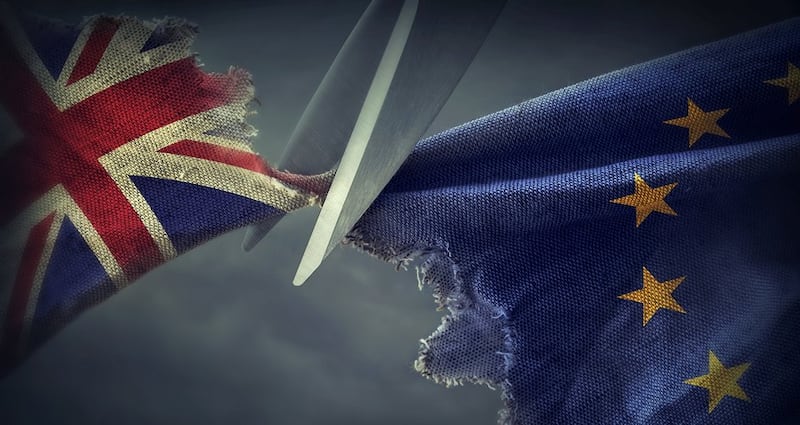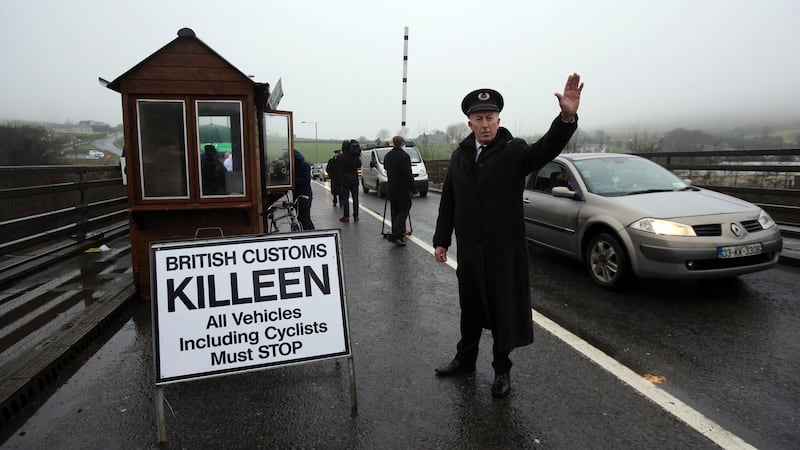Why is the Irish Border such a big deal with Brexit?
The 499-kilometre border running from Carlingford Lough to Lough Foyle will become the only land border between the UK and the European Union after Brexit.
The 1998 Belfast Agreement brought peace to Northern Ireland and removed the need for border checks.
It also established North-South rules and institutions that helped solidify the Peace Process. The border is currently invisible and neither side wants the return of infrastructure along the border or the creation of a hard border.

So what exactly is a hard border?
It is a frontier monitored and protected by customs officials and border inspectors, and potentially police or military personnel if there are security issues around the border.
The general fear is that the return of customs officials or border inspectors would be so unacceptable to people who travel freely across an open border that it would lead to anger and, potentially, violence.
That could in turn lead to a police or military presence along the Border to protect check points. Customs and security posts along the Border were regular targets of republican paramilitaries during the 30-year Troubles.
Why would there be a need for border checks?
Different customs rules, regulations and standards will apply in Northern Ireland and the Republic if the UK is leaving the EU so the different rules could have to be enforced at a border.

What do the EU and UK want along the Border?
Neither party to the Brexit negotiations wants to see the return of a hard border but they cannot agree a plan on how to achieve this.
So have they come up with anything to solve this problem?
The EU and UK agreed in a political deal in December 2017 that a "backstop" was required in the withdrawal agreement – the divorce deal – that would guarantee an invisible border in the event of no other solution to achieve this being found in a Brexit deal, either in a specific solution for Northern Ireland or in a broader EU-UK trade deal.
The December 2017 agreement also aims to protect North-South co-operation, support the all-island economy and safeguards the 1998 Belfast Agreement. In March 2018 the two sides agreed that there had to be a legal text – not just a political declaration – around how this option would work in practice should no better option be found.
What exactly is the backstop?
It is an insurance policy written into the withdrawal agreement, or Brexit treaty, guaranteeing no harder border on the island of Ireland.
It would only be used as a last resort or the default option if the EU and UK could not reach an overarching free trade deal that would make trade so frictionless that there would be no border between the EU and the UK, including on the frontier between Northern Ireland and the Republic.
How have the backstop talks developed?
Brussels believed a hard border could be avoided and the Belfast Agreement upheld if Northern Ireland remains fully aligned with the EU's customs union and parts of the single market after Brexit.
This would mean matching the rules north and south of the Border for customs, energy, environmental regulations and laws covering agriculture and fisheries,.
Northern Ireland would stick to EU rules covering state aid and would fall under the jurisdiction of the European Court of Justice in applying those rules. The EU’s chief negotiator Michel Barnier initially insisted that this backstop can only apply to Northern Ireland.
But the UK didn't like this?
No. British prime minister Theresa May said that no UK leader could agree to different rules applying to different parts of the UK that would separate Northern Ireland constitutionally and economically from the rest of the UK.
London argued that if the backstop only applies to Northern Ireland, it would effectively create a customs and regulatory border in the Irish Sea. The Northern Ireland’s Democratic Unionist Party (DUP), which keeps May’s minority Conservative government in power, also objected. They oppose any checks between Ireland and Britain and what they see as a border in the Irish Sea.
So what finally appeared in the withdrawal agreement on the backstop?
The UK government suggested a backstop that would keep the whole of the UK aligned with EU customs union after the post-Brexit transition period. The transition is a standstill period when current EU economic rules continue to apply over the UK. Under the agreement it is due to expire at the end of 2020 but it could be extended to 2022. The backstop would be triggered if the two sides fail to agree a new trade deal by that time that is far-reaching enough to avoid Irish border checks. Under the backstop, the North would also follow EU regulatory rules set down by the single market for goods. This would be enough to avoid a hard Irish Border, but would still involve some regulatory checks on goods crossing the Irish Sea.
But there are still problems?
Yes, while the UK government signed off on the withdrawal agreement, Theresa May faced fierce opposition to it in the House of Commons and the backstop was one of the reasons why the House of Commons rejected the withdrawal agreement by 230 votes on January 15th, inflicting the heaviest parliamentary defeat ever on a British government. It was defeated a further two times after that, prompting a postponement of Brexit until October 31st, 2019 (or before that if the withdrawal agreement is approved). Many Conservatives fear that once the backstop is triggered, there will be no way out of it for the UK. The DUP objects to the fact that regulatory checks would be needed on goods crossing from Britain to the North and that the North would have to follow some rules set down in Brussels.
Is there a way around this?
It is difficult. The EU has given the UK assurances that it will make every effort to negotiate a new trade deal to make the backstop unnecessary, or – if it is introduced – to ensure that it is in force for as short a time as possible. However, crucially, the EU insists that the withdrawal agreement itself must remain untouched. This says that the backstop remains in place "unless and until" another way is found to avoid a hard Irish Border. Many Conservative MPs and the DUP are not satisfied by non-binding assurances, fearing that the legal withdrawal agreement is the key document.
What if there is no agreement?
If there is no backstop, there will be no divorce deal and no transition period. In other words, there would be a disorderly Brexit and the UK would crash out of the EU in October 31st, 2019 unless an extension of that date is agreed. It is anyone’s guess how goods passing over the Irish Border would be treated in such a scenario but the UK’s chaotic departure from the EU could create all sorts of difficulties for cross-border trade and beyond.















